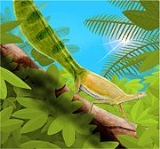
Hypuronector
Encyclopedia
Hypuronector is a genus
of extinct reptile from the Triassic
Period that lived in what is now New Jersey
. The etymology
of the name translates as "deep-tailed swimmer from the lake." A member of the Simiosauria, Hypuronector is related to the arboreal Megalancosaurus
. It was a small animal, estimated to be only 12 cm long in life. So far dozens of specimens of Hypuronector are known, but despite this, scientists have not found any complete skeletons. This makes attempts to reconstruct Hypuronector's body or life-style highly speculative and controversial.
than other Simiosaurs. It has long been accepted that Megalancosaurus was an arboreal chameleon
-like animal. However, Hypuronector has been suggested to be aquatic due to its deep, paddle-like tail and the fact that its remains were found in an ancient lake
bottom.
The only current remains of Hypuronector are too scanty to reach a certain conclusion about the lifestyle practiced by members of the genus
. The discovery of the animal's hands and feet might demonstrate adaptations present in its relatives for an arboreal lifestyle, which would help settle the debate. Unfortunately, paleontologists have no remains from Hypuronectors head, neck, feet or hands and thus must await future discoveries.
Genus
In biology, a genus is a low-level taxonomic rank used in the biological classification of living and fossil organisms, which is an example of definition by genus and differentia...
of extinct reptile from the Triassic
Triassic
The Triassic is a geologic period and system that extends from about 250 to 200 Mya . As the first period of the Mesozoic Era, the Triassic follows the Permian and is followed by the Jurassic. Both the start and end of the Triassic are marked by major extinction events...
Period that lived in what is now New Jersey
New Jersey
New Jersey is a state in the Northeastern and Middle Atlantic regions of the United States. , its population was 8,791,894. It is bordered on the north and east by the state of New York, on the southeast and south by the Atlantic Ocean, on the west by Pennsylvania and on the southwest by Delaware...
. The etymology
Etymology
Etymology is the study of the history of words, their origins, and how their form and meaning have changed over time.For languages with a long written history, etymologists make use of texts in these languages and texts about the languages to gather knowledge about how words were used during...
of the name translates as "deep-tailed swimmer from the lake." A member of the Simiosauria, Hypuronector is related to the arboreal Megalancosaurus
Megalancosaurus
Megalancosaurus is a genus of extinct reptile from the Late Triassic period of Northern Italy, and one of the best known drepanosaurids. The type species is M. preonensis; a translation of the animal's scientific name would be "long armed reptile from the Preone Valley."-Anatomy:Megalancosaurus was...
. It was a small animal, estimated to be only 12 cm long in life. So far dozens of specimens of Hypuronector are known, but despite this, scientists have not found any complete skeletons. This makes attempts to reconstruct Hypuronector's body or life-style highly speculative and controversial.
Lifestyle controversy
Despite their evolutionary relationship, it has been suggested by some scientists that Hypuronector may have had a different ecological nicheEcological niche
In ecology, a niche is a term describing the relational position of a species or population in its ecosystem to each other; e.g. a dolphin could potentially be in another ecological niche from one that travels in a different pod if the members of these pods utilize significantly different food...
than other Simiosaurs. It has long been accepted that Megalancosaurus was an arboreal chameleon
Chameleon
Chameleons are a distinctive and highly specialized clade of lizards. They are distinguished by their parrot-like zygodactylous feet, their separately mobile and stereoscopic eyes, their very long, highly modified, and rapidly extrudable tongues, their swaying gait, the possession by many of a...
-like animal. However, Hypuronector has been suggested to be aquatic due to its deep, paddle-like tail and the fact that its remains were found in an ancient lake
Lake
A lake is a body of relatively still fresh or salt water of considerable size, localized in a basin, that is surrounded by land. Lakes are inland and not part of the ocean and therefore are distinct from lagoons, and are larger and deeper than ponds. Lakes can be contrasted with rivers or streams,...
bottom.
The only current remains of Hypuronector are too scanty to reach a certain conclusion about the lifestyle practiced by members of the genus
Genus
In biology, a genus is a low-level taxonomic rank used in the biological classification of living and fossil organisms, which is an example of definition by genus and differentia...
. The discovery of the animal's hands and feet might demonstrate adaptations present in its relatives for an arboreal lifestyle, which would help settle the debate. Unfortunately, paleontologists have no remains from Hypuronectors head, neck, feet or hands and thus must await future discoveries.

